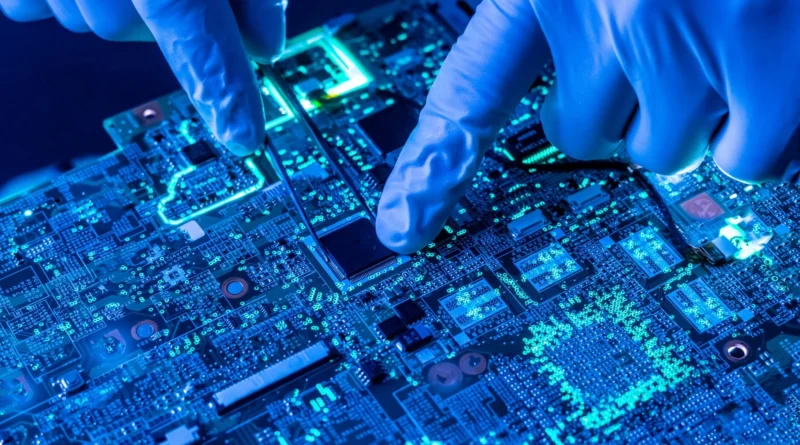Nanotechnology
Introduction to Nanotechnology
Nanotechnology is the branch of science and engineering that deals with creating and manipulating materials at an incredibly small scale — the nanoscale. At this level, one nanometer is just one-billionth of a meter (1 nm = 0.000000001 m).
Nanotechnology allows scientists to control atoms and molecules to design materials and devices with extraordinary properties. This technology is revolutionizing industries such as medicine, electronics, energy, and environmental science, making our modern world smarter and more efficient.
History and Development of Nanotechnology
The idea of nanotechnology began long before modern tools existed. The concept was first introduced by physicist Richard Feynman in his famous 1959 lecture, “There’s Plenty of Room at the Bottom.” He suggested that scientists could manipulate individual atoms to build new materials.
Later, in the 1980s, K. Eric Drexler popularized the term “nanotechnology” and envisioned molecular machines that could build anything atom by atom. The real progress began with the invention of powerful microscopes like the Scanning Tunneling Microscope (STM) in 1981 and the Atomic Force Microscope (AFM) in 1986.
Since then, nanotechnology has become one of the most dynamic and influential fields in modern science, with applications across nearly every industry.
The Nanoscale: Understanding the Small World
At the nanoscale, materials behave differently than they do at larger scales. A nanometer is so small that about 80,000 nanometers fit across a single human hair!
Atoms and molecules at this level show quantum effects, meaning their color, strength, electrical conductivity, and chemical reactivity can change. For example, gold nanoparticles appear red or purple instead of yellow, and carbon becomes stronger than steel when arranged as carbon nanotubes.
Understanding this small world gives scientists the power to engineer entirely new materials and technologies.
Tools and Techniques Used in Nanotechnology
Working at the nanoscale requires special tools and instruments. Some of the most important include:
Scanning Tunneling Microscope (STM): Allows scientists to see and move individual atoms.
Atomic Force Microscope (AFM): Measures surface structures and forces at the atomic level.
Electron Microscopes (SEM and TEM): Used to visualize nanoscale materials with extreme detail.
Nano-lithography and Self-assembly Techniques: Help create nanoscale patterns and structures.
These tools make it possible to study and manipulate matter at dimensions previously thought impossible.
Nano-materials and Their Properties
Nanomaterials are materials engineered at the nanoscale to achieve unique properties. Some examples include:
Carbon Nanotubes: Extremely strong and lightweight materials used in electronics and construction.
Graphene: A single layer of carbon atoms with outstanding electrical and thermal conductivity.
Quantum Dots: Tiny semiconductor particles that emit light, used in display screens and medical imaging.
Nanoparticles: Small particles that can improve strength, color, and chemical reactivity of materials.
These materials have applications ranging from flexible displays to high-performance batteries.
Nano-medicine and Healthcare Applications
Nanotechnology is transforming the field of medicine. Nano-medicine involves using nanoparticles and nanoscale systems for diagnosis, treatment, and prevention of diseases.
Targeted Drug Delivery: Nanoparticles carry medicines directly to affected cells, reducing side effects.
Cancer Treatment: Nano-carriers deliver chemotherapy drugs specifically to cancer cells.
Disease Detection: Nano-sensors can detect viruses, bacteria, or genetic changes at an early stage.
Nanotech-based medical tools offer hope for faster, safer, and more effective healthcare solutions.
Nanotechnology in Electronics
Modern electronics are becoming smaller, faster, and more powerful because of nanotechnology.
Nano Transistors: Used in microchips to increase speed and energy efficiency.
Nano Sensors: Detect temperature, pressure, and gases with high sensitivity.
Flexible Electronics: Graphene and nanowires enable bendable smartphones, screens, and wearable devices.
Thanks to nanotech, the digital devices we use daily are becoming smarter and more compact.
Nanotechnology in Energy
Nanotechnology plays a vital role in improving energy production and storage.
Solar Cells: Nanomaterials like quantum dots improve light absorption, making solar panels more efficient.
Fuel Cells: Nano-catalysts enhance chemical reactions for cleaner energy.
Batteries: Nano-engineered electrodes allow batteries to charge faster and last longer.
By increasing energy efficiency and reducing waste, nanotechnology supports the global shift toward renewable and sustainable energy.
Nanotechnology in the Environment
Environmental scientists use nanotechnology to protect and restore nature.
Water Purification: Nanofilters remove harmful metals, bacteria, and viruses from water.
Pollution Control: Nanoparticles help break down pollutants in air and soil.
Green Materials: Nanotech enables the creation of eco-friendly coatings and recyclable products.
These innovations help reduce environmental damage and promote sustainability.
Nanotechnology in Food and Agriculture
Nanotechnology is improving food quality, safety, and agricultural productivity.
Smart Packaging: Nano-sensors detect spoilage or contamination.
Food Preservation: Nanocoatings keep food fresh for longer periods.
Nano-fertilizers and Pesticides: Deliver nutrients and protection more effectively, reducing chemical waste.
By using nanotech, farmers can grow healthier crops and reduce environmental impact.
Nanotechnology in Textiles and Materials Science
Nanotechnology is widely used in textiles and material engineering.
Stain-Resistant and Waterproof Fabrics: Nano-coatings repel water and dirt.
Lightweight and Strong Materials: Used in sports gear, automobiles, and aircraft.
UV-Resistant Coatings: Protect materials from sunlight damage.
These smart materials are durable, efficient, and designed for comfort and performance.
Risks and Ethical Concerns of Nanotechnology
While nanotechnology offers great promise, it also raises important ethical and safety questions.
Health Risks: Some nanoparticles may be toxic if inhaled or absorbed by the body.
Environmental Impact: Improper disposal could harm ecosystems.
Ethical Issues: Concerns about privacy, surveillance, and misuse in military technologies.
To ensure safe development, governments and researchers are working on global nanotechnology regulations and ethical guidelines.
Global Research and Industrial Applications
Nanotechnology is a global field with contributions from countries like the United States, Japan, China, Germany, and South Korea.
Industries using nanotech include medicine, electronics, cosmetics, energy, and defense.
Many universities and research centers are developing nanorobots, smart materials, and nano-sensors that will shape the future of science and technology.
Future Prospects of Nanotechnology
The future of nanotechnology is incredibly exciting. Researchers are exploring:
Nanorobots: Tiny machines that can repair cells or deliver medicine inside the human body.
Nanocomputing: Computers built from molecular-scale components for ultra-fast processing.
Space Applications: Nanomaterials for lightweight spacecraft and radiation shielding.
As nanotechnology advances, it will continue to merge with fields like artificial intelligence (AI), biotechnology, and quantum computing, creating innovations that were once considered science fiction.
Conclusion: The Impact of Nanotechnology on the World
Nanotechnology is one of the most transformative scientific achievements of our time. It enables us to design smarter materials, cure diseases, protect the environment, and create a sustainable future.
By exploring the power of the nanoscale, scientists are not just building smaller things — they are building a better world. As research continues, nanotechnology will remain at the heart of innovation, driving progress across every area of modern life.

